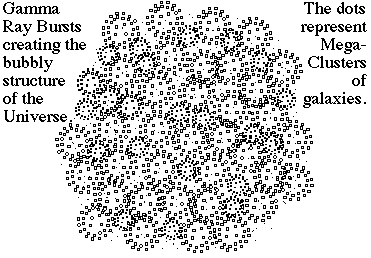Galaxies are not spread evenly throughout the universe. They form clusters. These clusters are not evenly spread out through the universe. They form huge bubble-like structures.
The Ball-of-Light Particle Model predicts these bubbles are caused from huge explosions. Exploding what? There is no name for these objects. You might call them "Mega-Galaxies."

When these objects explode, their remnants are "smaller" balls-of-light which the Ball-of-Light Particle Model predicts become the cores of galaxies. (See also Galaxy Formation)

While there is no name for what is exploding, the explosions of Mega-Galaxies have been observed and are presently called "Gamma Ray Bursts." (Some 2 to 3 Gamma Ray Bursts are observed each day and over 3,000 have been spotted since their initial discovery using US "Vela" spy satellites.)
There is no observational evidence that supports or contradicts it, but it is likely that the cores of these Mega-Galaxies were created when one of the two primary Balls-of-Light decayed. Then, the cores of these Mega-Galaxies themselves exploded, creating either: individual galaxies; or, larger objects that quickly decayed into groups or clusters of galaxies.
The explosion of these Mega-Galaxies created the bubbly structure that is observed in our portion of the universe. If no observational evidence is found for even larger bubbles in space -- that would indicate another level of explosions between the initial split and this one -- then it would seem this would be the "third energy level" in a series of energy levels that have a harmonic pattern.
Recently, the energy of the a Gamma Ray Burst has been measured as being 10 Billion times the energy released from a Supernova! 10 Billion Supernovas! Over 3,000 explosions like these have occurred since their discovery! The Ball-of-Light Particle Model is the only existing physics theory that predicts such explosions. Traditional theories can not explain such concentrated releases of energy.
(I heard some 2,000 possible theories of the nature of Gamma Ray Bursts were immediately eliminated from contention when the distance was estimated.)
The Ball-of-Light Particle Model predicts that when a Gamma Ray Burst occurs it adds to the background radiation of the earlier, larger explosions.
Because large scale explosions are happening within the context of larger explosions, the Ball-of-Light Particle Model predicts that there will be large volumes of galaxies in the universe that are moving in various directions with respect to the universe as a whole. This could cause large areas of galaxies moving in one direction from one Gamma Ray Burst to collide with large areas of galaxies from another Gamma Ray Burst moving in the opposite direction and mislead scientists as to how the Big Bang is expanding. To illustrate:
"Absolute motion of the Local Group and the Great Attractor. By measuring the anisotropy of the cosmological background [radiation] in two opposing directions in the sky (dipole effect) astronomers on earth can determine the motion of the Local Group with respect to this distant absolute rest frame. But they have first to take account of relative motions on a small scale: the Earth gravitates around the Sun at 30 kilometres per second; the Solar System moves around the centre of our Galaxy at 230 kilometres per second, and the Galaxy itself moves at 40 kilometres per second towards the centre of mass of the Local Group, in the direction of its large neighbor, the Andromeda galaxy.
Correcting for these motions internal to the Local Group, there remains a velocity of 600 kilometres per second in the opposite direction to the Galactic rotation, perpendicular to the line joining the Solar System to the Galactic centre, and about 27 degrees above the Galactic plane. The gravitational attraction of the Virgo supercluster can explain only one of these velocity components (green vector). The other velocity component (blue vector), which is larger, is directed towards the Hydra-Centaurus supercluster, itself under the influence of a yet stronger and more distant overdensity, formed by an enormous concentration of galaxies, is supposed to be responsible for the general drift of the Local Group, the Virgo supercluster, and the Hydra-Centaurus supercluster with respect to the absolute reference frame constituted by the cosmic background radiation."
Page 397, The Cambridge Atlas of Astronomy, 3rd Ed.
While described as moving towards a "great attractor," our Local Group and related superclusters could be moving away from the center of a Gamma Ray Burst. The "enormous concentration of galaxies" could be a collision area between our Gamma Ray Burst and another Gamma Ray Burst.
Distant Supernovas and the Expansion of the Universe
Recent studies of distant supernovas has indicated something -- seemingly -- very odd! While most astronomers seem to agree that the universe is experiencing a Big Bang, and that the further away a galaxy is, the faster it is receding from us, studies of distant supernova have indicated the opposite. Instead of the expansion of the Big Bang slowing down, these studies indicate it may be speeding up!
How is this possible? The Ball-of-Light Particle Model predicts distant massive explosions could be hurling galaxies at very high velocity -- and thus supernovas embedded within these distant explosions -- towards our region of the universe.
These Supernova studies contradict traditional theories of star formation, galaxy formation, and the Big Bang, but agree with the Ball-of-Light Particle Model.
Under Construction
The History of Gamma Ray Bursts
Under Construction